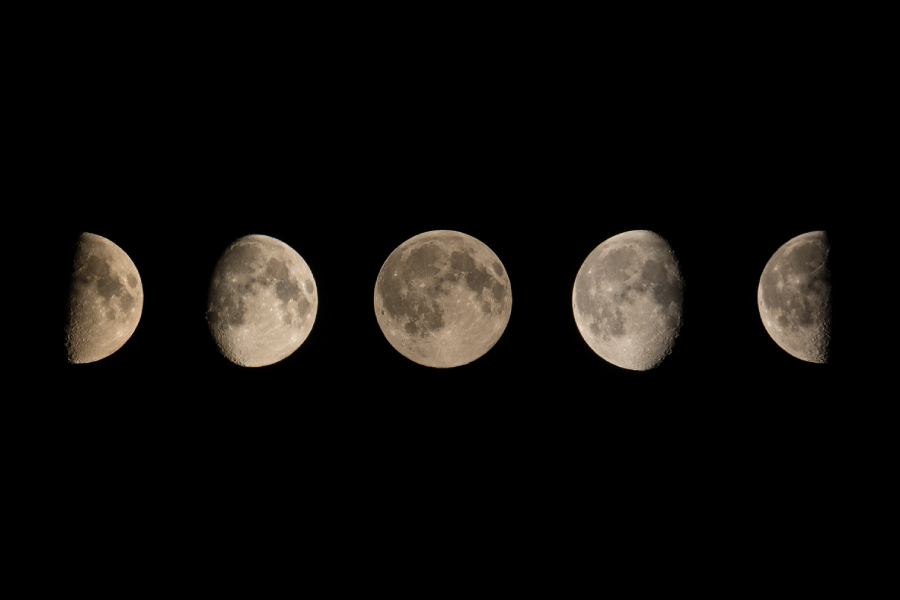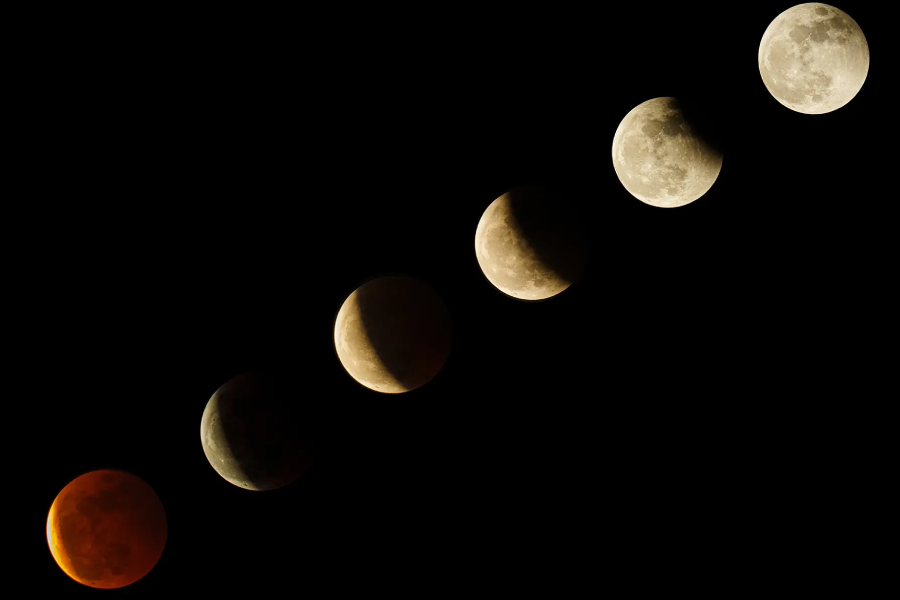The ever-evolving dance of light and shadow across the lunar surface has entranced humanity through the ages. From breathtaking full moons to the slim-waning crescent that rises before dawn, the moon’s phases mark time and inspire poetry, madness, and science.
But what causes the phases of the moon that beam down upon us? What drives this celestial transformation so dictated our forerunners’ rituals and rites and still captivates us today? This article will illuminate the remarkable mechanics behind the cycles that define the phases of the moon.
Exploring common questions, we will unpack what the waxing, waning, and lunar quarter cycles are telling us; hint – it involves the moon’s celestial choreography with our life-giving Sun and Earth.
We will demystify the science, dismiss misconceptions, and hopefully instill renewed awe for the astronomical forces behind one of nature’s subtlest yet most prominent wonders.
What Causes the Phases of the Moon?
What causes the phases of the Moon? The phases of the Moon are caused by the relative positions of the Moon, Earth, and Sun and how much of the Moon’s sunlit side can be seen from Earth.
The Moon orbits around the Earth, while the Earth orbits around the Sun. So, the portion of the Moon that is illuminated by the Sun keeps changing from our perspective here on Earth.
When the Moon is between the Earth and the Sun, the side of the Moon facing us is not illuminated. From Earth’s perspective, this results in the Moon temporarily disappearing from the sky.
As the Moon continues orbiting, the side we see gradually becomes more illuminated by direct sunlight – transitioning from a thin crescent to a half moon then to a fully lit full moon phase two weeks later before repeating the cycle.
So in essence, it’s the fact that the Moon orbits the Earth while the Earth orbits the Sun that results in us seeing different portions of the Moon’s daylight side exposed over a month. This causes the moon phases that have shaped cultures and concepts of time since ancient eras.

Lunar eclipses
Occurrence and phenomena
Lunar eclipses occur when the Moon, Earth, and Sun align so that the Earth casts its shadow on the Moon’s surface. This can only happen during a full moon when the Moon is directly opposite the Sun.
As Earth’s shadow crosses the Moon, some sunlight still spills around Earth’s edges – refracting and coloring the lunar face with a dim red glow rather than going completely dark. When the eclipse reaches totality, the outer corona of the Sun can also become faintly visible, surrounding the darkened, reddened Moon.
The corona is usually obscured by the Sun’s brightness. Its brief visibility against the eclipsed Moon provides astronomers with rare opportunities to study activity around the Sun itself. However, totality itself lasts barely over an hour before the first slivers of sunlight return to re-illuminate the Moon’s
Lunar month
A lunar month refers to the Moon’s orbital period. This is the time taken for the Moon to complete one revolution around the Earth relative to the background stars.
On average, a lunar month takes 29.5 days to complete. But it can vary slightly from 29 to 30 days due to complex orbital mechanics with the Sun-Earth system over time. The phases of waxing, waning, and lunar quarters all line up with this cycle.
As the Moon orbits around the Earth in an ellipse, we see its sunlit portion gradually change shape and apparent size each night. We observe this as the familiar lunar phases in our sky over the month.
Solar eclipse
Solar eclipses happen when the Moon passes directly between Earth and the Sun, blocking sunlight totally or partially as its shadow traverses parts of Earth, resulting in the obscuration of the sun’s face.
Eclipses require precise new moon alignment with the eclipse seasons from the Moon’s tilted orbit intersecting Earth’s own orbit, enabling the Moon to centrally eclipse the Sun along a narrow path.
Orbital motion
The Moon takes about 29 days to orbit Earth in an elliptical path that is slowly widening over time. This tilted, revolving orientation exposes different sections to sunlight from Earth’s viewpoint – resulting in the familiar moon phases astronomers observe every lunar month.
When the Moon moves between the Sun and Earth, its darkened hemisphere faces us – termed the new moon phase. As the moon progresses orbitally, increasing proportions become illuminated by the Sun’s rays.
This occurs until full intensity is reached at the full moon phase halfway through the lunar cycle – before the gradual return to new moon alignment repeating the phases. The precise dance between the moon’s own orbit and Earth’s shapes these observed phases over sequential 29-day periods.

Cycle of Phases
The sequential changes in the Moon’s appearance
As the Moon orbits Earth, its changing orientation to the Sun results in different sections getting illuminated. This cyclically alters the visible sunlit portion from an Earthly view – giving rise to the sequence of moon phases over a lunar month period between new moon alignments.
During the gibbous waxing and waning phases, more than half, but not all, of the observable Moon gets lit by sunshine. The Moon’s orbit finally aligns it directly opposite sunlight, manifesting the brilliantly lit full phase when the entire visible side beams under solar illumination.
The cyclic nature of its phases
The new moon phase occurs when the lunar face directly facing Earth falls into complete shadow. As its orbital position shifts, thin crescent slivers emerge from the darkness.
These crescent slivers progressively fatten into a half moon phase. The moon then transitions into a brilliantly lit full moon phase before waning back down. This completes the approximately 29-day moon cycle.
This perpetual cycle of illumination change emphasizes the cyclic, celestial choreography between the Sun, Moon, and Earth.
Sunlit portion of the Moon’s surface
As the Moon orbits Earth, its changing position alters the angle at which light from the Sun strikes its surface. From Earth, this affects how much of the sunlit portion we can see – giving rise to the visible lunar phases that cycle through crescent, half, full and back over 29 days between new moon alignments.
When the Moon lies between Earth and the Sun, its sunlit half faces away. As it progresses in its orbit, increasing proportions face Earth. More sunlight reflects off the nearside, illuminating larger slivers visible to terrestrial observers.
Peak illumination occurs at the 180-degree full moon alignment. This is before gradually receding through the waning phases as the angle of sunlight shifts when the Moon travels back towards the new moon positioning in front of the Sun.
First-quarter Moon and third-quarter Moon
The first quarter phase occurs around seven days after a new moon alignment. The Moon now appears roughly half illuminated – resembling a “D” shape to observers on Earth.
This phase marks a 90-degree angle made between the Sun-Earth-Moon orbital positions, with half the Moon’s Earth-facing side now bathed in sunlight.
Following the full moon, the third quarter phase sees the Moon illuminated on the opposite side compared to the first quarter. Here, just over 50% of the total surface area reflects light back at Earth – giving a “C” visual profile.
Conclusion
The intricate orbital dance of the Moon, Earth, and Sun fundamentally causes the phases of the Moon that have captivated humanity through the ages.
As the Moon and Earth orbit in cosmic tandem around the central Sun, the phases change, causing different parts of the Moon to be visible from our viewpoint on Earth.
Revealing slim crescent moon slivers that gradually wax into full moon brightness halfway through its 29-day orbit cycle before reversing through waning phases as one cycle concludes. Then, the next lunar orbit cycle begins again with emerging crescent phases.
We hope this in-depth explanation has illuminated the underlying astronomical forces driving the endless Moon phase cycle that so fascinates those gazing up at the night sky and pondering what causes the phases of the Moon.
